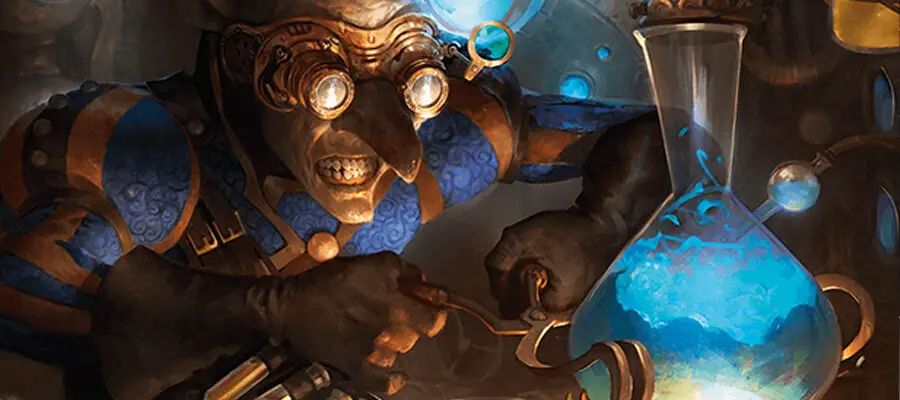This article’s featured image for D&D 5e Artificer Subclass Ratings is from Guildmasters’ Guide to Ravnica. This article contains affiliate links that add gold to our coffers.
Let’s find out which of D&D 5e’s Artificer subclasses are in charge and which ones wallflowers on prom night! I enjoy analyzing subclasses to find their strengths and weaknesses. It helps me queue up the kinds of characters I eventually want to play when their times come.
Premise and Rating System
I’m rating each subclass based on the game overall for Artificers only, so I’m not comparing a Druid subclass to an Artificer subclass. That wouldn’t feel fair. I also rate each subclass based on five criteria:
- Subclass Features: How the abilities and perks synergize. I look at all levels of play, not just low levels like many do these days. I play at high levels plenty enough to look at those features.
- Game Design: How well do the features avoid misunderstandings and how well do they fit into the game overall? Features that are clunky or feel exploitative will suffer.
- Fun: If a subclass feels easy and enjoyable for the average player to pick up, it will be rated well here.
- Versatility: I like to see subclasses that can be played and flavored in multiple ways without feeling stuck.
- Lore & Roleplaying: Subclasses that evoke fantasy and live up to it will do well here.
This clearly isn’t a science, but it’s the system that works for me! It also helps me to be objective and not feel burdened by community perceptions.
Quick Poll: Favorite Artificer Subclasses from the 5e Community
Before or after you read through my Artificer subclass ratings, let us know which is your favorite! Voting will reveal the votes of others, too.
Skip to Your Favorite Artificer Subclass Rating
— Alchemist
— Armorer
— Artillerist
— Battle Smith
Alchemist Artificer Subclass (TCoE)
Bonus proficiencies: Alchemist’s Supplies (or other artisan’s tools if redundant)
Bonus spells:
- Healing Word, Ray of Sickness
- Flaming Sphere, Melf’s Acid Arrow
- Gaseous Form, Mass Healing Word
- Blight, Death Ward
- Cloudkill, Raise Dead
Summary of subclass features: Create Experimental Elixirs for healing, flight, AC, body morphing, speed, and 1d4 boosts. Deal bonus necrotic, acid, fire, or poison damage from spells or enhance healing spells. Experimental Elixirs later can cleanse maladies and grant temporary hitpoints. Finally, gain resistance to acid and poison damage, immunity to the poisoned condition, and cast specific high-level healing spells once without a spell slot per long rest.
- Subclass Features: ★★★
- Game Design: ★★★
- Fun: ★★★
- Versatility: ★★★
- Lore & Roleplaying: ★★★
Flutes’ Evaluation (3/5): The Alchemist has interesting options, but it doesn’t fulfill the player-fantasy of playing an Alchemist. It relies on spellcasting instead of alchemy. While there are interesting options and it won’t be a dead-in-the-water subclass, it runs in the middle of the road with its scores.
Even if it’s the weakest Artificer, I like some of its mechanics. I didn’t like its Experimental Elixirs at first, but they’ve grown on me. I especially like adding its Intelligence modifier to specific damage and healing spells.
This subclass is ok, but it doesn’t feel like an Alchemist as I’d envision it. If you want to play a proper Alchemist, consider purchasing Taron Pounds’ Alchemist Class on the DMs Guild. My review video of that class is here:
Armorer Artificer Subclass (TCoE)
Bonus proficiencies: Heavy Armor, Smith’s Tools (or other artisan’s tools if redundant)
Bonus spells:
- Magic Missile, Thunderwave
- Mirror Image, Shatter
- Hypnotic Pattern, Lightning Bolt
- Fire Shield, Greater Invisibility
- Passwall, Wall of Force
Summary of subclass features: Use heavy armor without needing Strength to wear it effectively. Switch between melee or ranged specialties and abilities with your armor “Iron Man armor.” Gain Extra Attack, infuse your armor with multiple Infusions instead of one, and later enhance your armor’s specialties.
- Subclass Features: ★★★★
- Game Design: ★★★★★
- Fun: ★★★★
- Versatility: ★★★★
- Lore & Roleplaying: ★★★★
Flutes’ Evaluation (4/5): The Armorer is well-designed in that it plays into a particular play style while maintaining options. It’s not too strong or too weak. The spell list is solid. Using heavy armor without needing investment in Strength is fantastic. I enjoy how the Armorer gains additional Infusions for its armor. Armorers have tremendous potential for teamwork in this team game, earning them a healthy rating.
This subclass has a special place in my heart for Wizard multiclassing, but many Wizards can take one or even two levels of Artificer to get enough utility. Three levels of investment is a heavy tax to get a Wizard heavy armor without Strength limitations.
My favorite thing about the Armorer is how it can completely focus on its armor for defense and offense. This versatility gets me excited to explore Infusion possibilities without juggling weapons.
Artillerist Artificer Subclass (TCoE)
Bonus proficiencies: Wood Carver’s Tools (or other artisan’s tools if redundant)
Bonus spells:
- Shield, Thunderwave
- Scorching Ray, Shatter
- Fireball, Wind Wall
- Ice Storm, Wall of Fire
- Cone of Cold, Wall of Force
Summary of subclass features: Create cannons/turrets that blast and protect. Use wands and similar items as if they’re firearms and use them more effectively. Later, your cannons become more impactful.
- Subclass Features: ★★★★
- Game Design: ★★★★★
- Fun: ★★★★
- Versatility: ★★★★★
- Lore & Roleplaying: ★★★★★
Flutes’ Evaluation (5/5): Artillerists come frontloaded with useful options and good spells, especially Shield and Wall of Force (though the spell progression is slow for Artificers). The damage scaling is healthy without being absurd. In a game that doesn’t support firearms very well, this subclass seems to fulfill many players’ character concepts. This is evidenced by my passive observation of how many players choose to play this character.
I appreciate how the Artillerist doesn’t have any bad subclass features. They all can have their time and place to be useful (except for its spells). I also believe that when someone pictures an Artificer, some kind of Artillerist is probably what they envision.
There is a steeper learning curve with the Artillerist than with many other player options. This can hinder fun while new players figure it out, but it’s not a big deal. Not all of its spells are great options at the levels they’re gained; even experienced players may underestimate how that’s problematic. Anyone who invests the time to learn its ins and outs will enjoy the Artillerist as they avoid any pitfalls.
Battle Smith Artificer Subclass (TCoE)
Bonus proficiencies: Martial Weapons, Smith’s Tools (or other artisan’s tools if redundant)
Bonus spells:
- Heroism, Shield
- Branding Smite, Warding Bond
- Aura of Vitality, Conjure Barrage
- Aura of Purity, Fire Shield
- Banishing Smite, Mass Cure Wounds
Summary of subclass features: Use martial weapons with your Intelligence score. Create a level-scaling Steel Defender construct pet who aids you in combat. You get Extra Attack and can jolt people with your attacks. Your jolts and Steel Defender become more impactful at higher levels.
- Subclass Features: ★★★★★
- Game Design: ★★★★★
- Fun: ★★★★★
- Versatility: ★★★★★
- Lore & Roleplaying: ★★★★
Flutes’ Evaluation (5/5): As one of the rare subclasses that can alter the ability score that affects its attacks, the Battle Smith is already useful. Throwing in a scaling pet, the subclass secures itself as a solid option. Like Artillerist, Battle Smiths get the Shield spell. The player fantasy is extremely fulfilled by this subclass. Battle Smiths make great characters that won’t disappoint players. The subclass features are straightforward without any “trap” options that could result in poor play experiences.
I wish more effort was invested in describing how a magical weapon can use Intelligence instead of Dex/Str. This detail can certainly be roleplayed and rationalized, but I would bet many players don’t understand it.
My personal choice for playing a Battle Smith would be to use a crossbow as a sniper while using my Steel Defender for partial cover from enemy attacks!
Artificer Subclass Rankings Best to Worst
- Battle Smith
- Artillerist
- Armorer
- Alchemist
I doubt this ranking list is controversial. The Alchemist is famously considered the weakest, most disappointing Artificer subclass. Battle Smith and Artillerist certainly duke it out for the top spot. Armorer is solid on its own.
What is the best Artificer subclass?
Battle Smith is the best Artificer subclass, though Artillerist is just behind it. The overall subclass feature quality and multiclass opportunities of the Battle Smith are profound.
What is the worst Artificer subclass?
The Alchemist Artificer is the worst subclass for Artificers. It offers the slightest benefits and doesn’t transform gameplay like the others. If you want to play an Alchemist, I recommend playing the Alchemist class by Taron Pounds (available on the DMs Guild).
Conclusion
Artificers make solid characters, but they don’t always nail the character fantasy that players hoped for when the Artificer was released. Subclasses for the Artificer play into its strengths well. I’ve heard game designers dunk on this class for being bad or boring, but I rarely hear players with the same criticisms. I definitely agree that WotC missed an opportunity when they defaulted to having Artificers focus on spellcasting.
Cast Message in the comments below to tell us about your experiences with the Artificer. Which subclasses have you played and how well did they turn out?
We have more Artificer and character class articles before you go!





Your ranking of artificer subclass is is identical to mine, but I write here to talk about the alchemist. I think it’s an underrated subclass. I agree with all of your criticisms, but I don’t buy the underlying idea that the concept of this subclass doesn’t deserve to exist, unlike many people preach on D&D forums (not you, I know).
Firstly, the concept is very good, as a “profession”, it is fully justified as a subclass of Artificer and its introductory text, despite being brief, is well supported by the class. Many complain that she doesn’t do much about alchemist’s supplies but, It this really necessary? Xanathar’s guide already offers some ideas of what to do with this tool, and you can make a number of others with your DM’s permission.
And it has the spells. Okay, the alchemist spell list isn’t objectively as powerful as the other subclasses, but it’s far from being bad and embraces strongly the theme. Speaking of which, the main point of criticism I see about the Alchemist is mechanical choice, few understand that it is based on alchemical transformations: Albedo (Healing); Nigredo (Necrotic); Rubedo (Fire); And Citrinitas (Poison and Acid).
Having said all that, the subclass is indeed flawed, for three reasons:
1- Not Competitve: This subclass is not a good healer and its additional damage is not enough to be on par with other artificer subclasses or other classes. All it does in these respects is add the Intelligence modifier to damage or healing rolls. Regarding the damage potential, it is necessary to say that all three other artificer subclasses (Armorer, Artilerist and Battle Smith) have other means of dealing additional damage, either with extra attack, bonus action or reaction. The Alchemist, on the other hand, does none of these things. I suggest adding another 5th-level ability that allows you, while holding an alchemist’s supply in your hands, to be able to brew an explosive magic potion as a bonus action and hurl it at your opponent, dealing 1d6+INT fire damage, poison, acid, or necrotic on a hit. This damage increases to 2d6+INT at 9th level and 3d6+INT at 15th level.
2- Experimental Elixir: Deserved to have an upgrade at levels 9 and/or 15, depending of effect. My suggestion is: Healing (Level 9 drinker regains 4d4+INT and 15 8d4+INT); Swiftness (Level 9 drinker gains 20ft and Level 15 gains 30ft); Resilience (Level 9 gains +1 in all saving throws and Level 15 AC and saving throws increase to +2) Flight (Level 9 increase the time for 1 hour and Level 15 increase the flying speed to 30 ft). Boldness and Transformation are strong enough for every level. And maybe there should be other additional experimental elixir options to meet other demands than alchemy could do.
3- Level 9 and 15 features are good but…- I don’t think are all this. Resistance to acid and poison damage should go to level 9 and at level 15 it evolves into immunity. Level 15 should include the regenerate spell. None of these improvements would make these features overpowered.
Thank you for sharing your take on the Alchemist! I am certain I could enjoy playing one, so it’s not junk by any means. I’d definitely want to use the Alchemist’s Almanac by heavyarms to supplement my alchemical desires, which I have a review for if you’re interested. https://www.flutesloot.com/dnd-5e-alchemy-almanac-crafting-herbalism-harvesting-crafting-supplement/